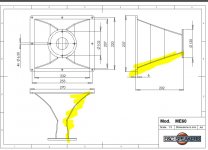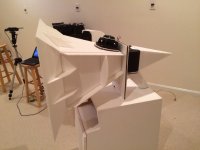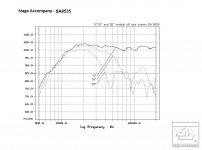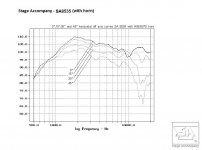Some sort of a critical diameter/X-section makes them visible/invisible, Bill?
I'm also forgetting what shape you made your printed ports.

In a coentrant horn, each segment of the horn is responsible for a fraction of the bandwidth. For instance, the first four inches or so are responsible for the spectrum from about 2khz and up.
Smaller taps are better, because they interfere with the frequency response less.
Putting the taps out further interferes with the frequency response less. IE, a 3/4" tap that's one inch from the throat is far more destructive than a 3/4" tap that's three inches from the throat.
It's a juggling act.
Luckily, there's a simple solution, which is to copy what works. My midranges taps work, so do Danley's
Well, there's always that. But it precludes using the same conical expansion angle as well, which may or may not be what one looks to do, especially when one thinks about the vertical dispersion of an AMT. 
But, yes, absolutely, start by copying and riff from there than from a clean slate (until one knows what they're doing).
And thanks for the info, Bill!
But, yes, absolutely, start by copying and riff from there than from a clean slate (until one knows what they're doing).
And thanks for the info, Bill!
Very interessting post! So what hear from you, it´s maybe the best to start with an skinny ribbon shaped tab.
Which advantages and disadvantages do you see between the differnt placement of the tabs?
Also very interessting. Do you have an picture of the CoSynes Horn (where the tabs where not in the corners)?
Do you still have measurments of the both version (off axis problems)?
Hello. Just checking in to learn what you decided as next steps? Interested in how this goes.
The horizontal coverage pattern looks a little wide. What angles are you using for the Constant Directivity flare walls? You might get dead spots on either side of the on-axis response. Kinda like three beams of sound...on-axis, and at the extreme edges of the coverage pattern which wouldn't be good. I suggest looking at the B&C ME60 Horn geometry which shows good performance in the coloured polar map...
B&C Speakers
https://www.bcspeakers.com/media/W1siZiIsIjIwMTMvMDQvMDUvMTAvMTMvMzUvMjMwL2ZpbGUiXV0
B&C Speakers
https://www.bcspeakers.com/media/W1siZiIsIjIwMTMvMDQvMDUvMTAvMTMvMzUvMjMwL2ZpbGUiXV0
Attachments
Wow never saw this thread yet. Glad to see someone else is going to try the AMT SH idea. I have my parts I just havent started yet. I have a TPL200 and Celestion 4"closed back mids. Was going to try and just build the high and mid section and see how I go but never got started yet. Been over a year now or so. My horn was also going to be more of a 80x 40 radiation shape and more of a standard single 15"JBL pa speaker shape. So my goals were to build something like a SH96 or 64 on its side externally.
Synergy with an AMT is perhaps one of the best sounding speakers I have ever made or heard. It has the ability to “stun” a listener - that is someone coming by to casually listen will be stopped dead in their tracks and have no choice but to stay and listen and be blown away and speechless. Stunned in other words.
Here is mine with a 30in wide mouth and made all in foam core. Heil AMT and B&C 6.5in Nd driver for mids. Coupled with a FLH for bass, the combo is staggeringly good.
One thing about an AMT is that it lacks the piston power to develop horn loaded gain typically seen with conventional moving voice coil and diaphragm drivers. If you are used to getting circa 10dB gain with conventional drivers, I have found that there is about zero gain with an AMT in a horn.
Important point with construction is that the transition from the AMT to horn walls needs to be smooth as possible and devoid of sharp edges or sudden transitions.
Here is mine with a 30in wide mouth and made all in foam core. Heil AMT and B&C 6.5in Nd driver for mids. Coupled with a FLH for bass, the combo is staggeringly good.
One thing about an AMT is that it lacks the piston power to develop horn loaded gain typically seen with conventional moving voice coil and diaphragm drivers. If you are used to getting circa 10dB gain with conventional drivers, I have found that there is about zero gain with an AMT in a horn.
Important point with construction is that the transition from the AMT to horn walls needs to be smooth as possible and devoid of sharp edges or sudden transitions.
Attachments
Last edited:
xrk, I'm kind of surprised that it works so well. I would've thought the AMT diaphragm would get shoved around too much by pressure from the mids (that the pressure would be even stronger at the throat, working something like this:

Or is it the way that AMTs work (squeezing rather than flat-pushing) that makes the solid pressure wave coming in be not much of a problem?
Cool looking horn, by the way. I keep thinking it would be interesting to make a foam-core synergy speaker using all neodymium drivers for featherweight!

Or is it the way that AMTs work (squeezing rather than flat-pushing) that makes the solid pressure wave coming in be not much of a problem?
Cool looking horn, by the way. I keep thinking it would be interesting to make a foam-core synergy speaker using all neodymium drivers for featherweight!
Thanks, Bwaslo. Your spreadsheet was critical to making the panels.
I think it works because the pressure gradient preferentially moves from high to low and the open end is lower pressure. There probably is some modulation of the AMT membrane by the mid but since it is not pistonic (but a squeezing of the pleated membrane motion) the two actions seem to not be interfering. Although I have not measured the cross-talk, it sounds great.
I think it works because the pressure gradient preferentially moves from high to low and the open end is lower pressure. There probably is some modulation of the AMT membrane by the mid but since it is not pistonic (but a squeezing of the pleated membrane motion) the two actions seem to not be interfering. Although I have not measured the cross-talk, it sounds great.
Thanks, Bwaslo...
xrk, if you have any entrepreneurial inclinations, you should consider putting a kit of that horn together. I wonder if there's a fast/inexpensive/CNC way to cut out foam core pieces? (probably not laser I suppose).
[edit: I just noticed that you also used just one LF driver on the horn. Works really well, doesn't it? I think people get too hung up on high-efficiency, high SPL on Synergy/Unity horns for home use, that's not really the point. At all. Single driver works better for the tweeter's benefit and the asymmetry tends to help smooth the response, at least by eye. Though for PA use, of course SPL becomes pretty much everything]
Last edited:
Synergy with an AMT is perhaps one of the best sounding speakers I have ever made or heard. It has the ability to “stun” a listener - that is someone coming by to casually listen will be stopped dead in their tracks and have no choice but to stay and listen and be blown away and speechless. Stunned in other words.
Here is mine with a 30in wide mouth and made all in foam core. Heil AMT and B&C 6.5in Nd driver for mids. Coupled with a FLH for bass, the combo is staggeringly good.
One thing about an AMT is that it lacks the piston power to develop horn loaded gain typically seen with conventional moving voice coil and diaphragm drivers. If you are used to getting circa 10dB gain with conventional drivers, I have found that there is about zero gain with an AMT in a horn.
Important point with construction is that the transition from the AMT to horn walls needs to be smooth as possible and devoid of sharp edges or sudden transitions.
For the most part, horns and waveguides don't increase the efficiency of a loudspeaker, they just focus the energy into a narrower beam. For instance, a compression driver on a 1" horn will focus it's energy into a narrow beam below 13,500hz.
Above 13,500Hz, there's very little gain, because there's nothing constraining the wavelengths into a smaller angle. (Because 13500Hz is an inch long, and the throat is an inch long.)
When you replace that compression driver with a ribbon, that frequency where there's no "horn gain" drops significantly, because the throat is so large. For instance, with a ribbon that measures 4" x 1.5" you're not going to have any horn gain at all above 10khz, and little above 3khz.
Interested.Synergy with an AMT is perhaps one of the best sounding speakers I have ever made or heard.
XRK, what is your xover points?
Re: the (lack of) horn gain on a ribbon/planar/AMT.
Patrick, your math is good; it definitely works about exactly as you stated in practice. I use Stage Accompany 8535 "RCD" planar HF drivers a lot. Their exposed diaphragm area is approx. 1.125"x6.5".
I have many measurements of the driver in their factory horn, but not bare. However, SA's published "with-horn" measurements agree with mine quite closely, so I'm attaching their bare-vs-horn measurements here.
One can see that the with-horn sensitivity droops down to meet the 103db/W bare-driver sensitivity right about at 3KHz.
The SA "H8535/70" horns are nominally 50x70 degrees with a 9.5" square mouth.
I have one extra bare pair of these drivers on hand, and would really like to build a 3-way Synergy-ish PA design around them if possible. I'm pretty sure I can cross these over at 1.5K or even a bit lower with a big horn.
I too have always wondered about the 'push back' from the bass / midrange that a planar HF driver like this would experience in a co-entrant horn. I strongly suspect it doesn't matter, but it would sort of stink to spend a lot of effort and $$$$ and find out otherwise.
Anyone have an idea what would be a good methodology to measure the magnitude of the effect... my thoughts were:
A) Disconnect the tweeter, shunt it with 0.1 ohm or so, and measure the voltage across it with the other drivers playing.
B) Make an in-situ IMD measurement. No crossover; play very loud 3KHz bursts into the HF driver, play various other bursts though the other drivers, look for sidebands appearing around +-3KHz.
I'm thinking that B (done with the ribbon driven to a level near its excursion limits) is the meaningful test, but I dread trying it.
Patrick, your math is good; it definitely works about exactly as you stated in practice. I use Stage Accompany 8535 "RCD" planar HF drivers a lot. Their exposed diaphragm area is approx. 1.125"x6.5".
I have many measurements of the driver in their factory horn, but not bare. However, SA's published "with-horn" measurements agree with mine quite closely, so I'm attaching their bare-vs-horn measurements here.
One can see that the with-horn sensitivity droops down to meet the 103db/W bare-driver sensitivity right about at 3KHz.
The SA "H8535/70" horns are nominally 50x70 degrees with a 9.5" square mouth.
I have one extra bare pair of these drivers on hand, and would really like to build a 3-way Synergy-ish PA design around them if possible. I'm pretty sure I can cross these over at 1.5K or even a bit lower with a big horn.
I too have always wondered about the 'push back' from the bass / midrange that a planar HF driver like this would experience in a co-entrant horn. I strongly suspect it doesn't matter, but it would sort of stink to spend a lot of effort and $$$$ and find out otherwise.
Anyone have an idea what would be a good methodology to measure the magnitude of the effect... my thoughts were:
A) Disconnect the tweeter, shunt it with 0.1 ohm or so, and measure the voltage across it with the other drivers playing.
B) Make an in-situ IMD measurement. No crossover; play very loud 3KHz bursts into the HF driver, play various other bursts though the other drivers, look for sidebands appearing around +-3KHz.
I'm thinking that B (done with the ribbon driven to a level near its excursion limits) is the meaningful test, but I dread trying it.
Attachments
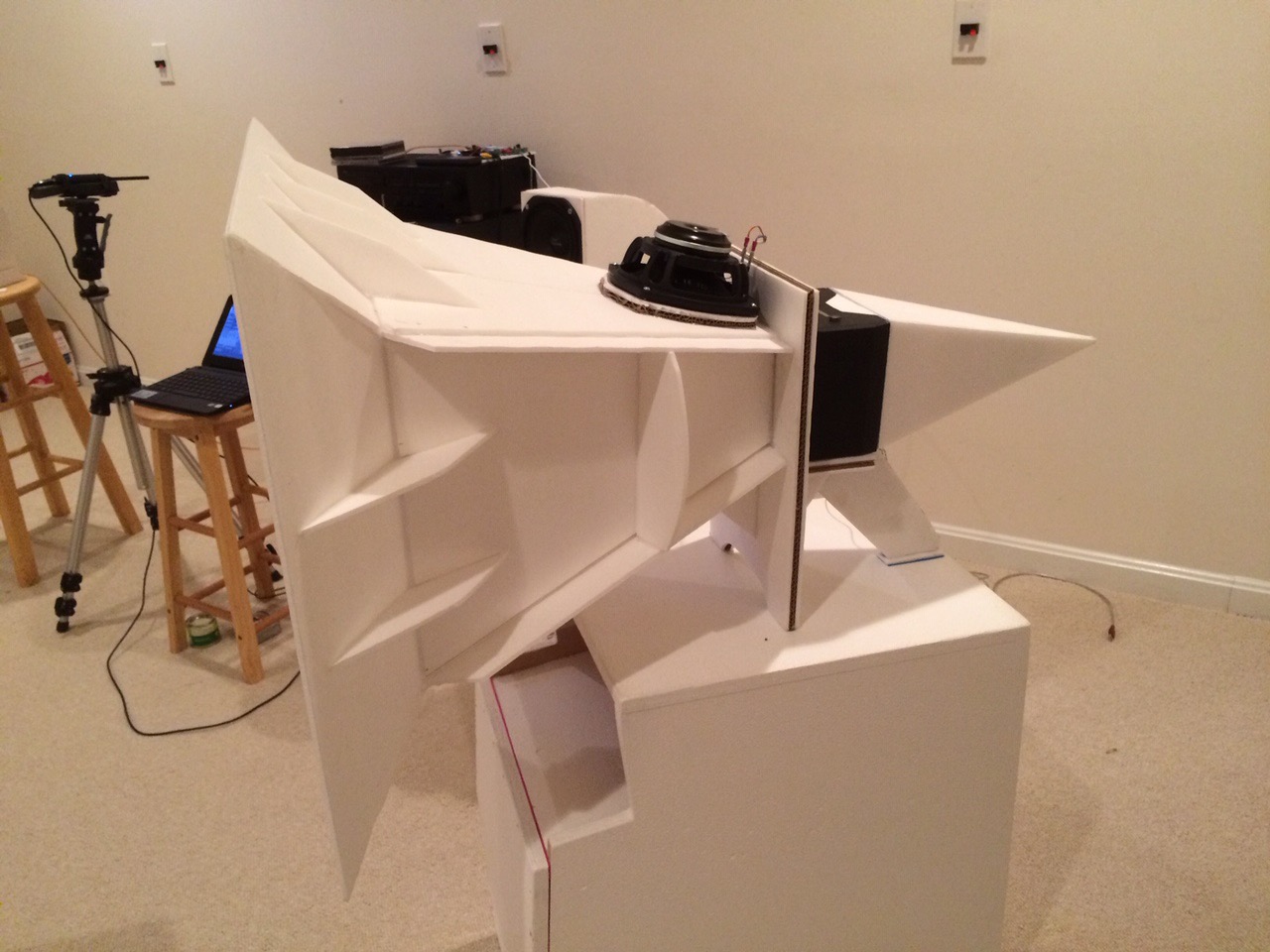
For the most part, horns and waveguides don't increase the efficiency of a loudspeaker, they just focus the energy into a narrower beam. For instance, a compression driver on a 1" horn will focus it's energy into a narrow beam below 13,500hz.
Above 13,500Hz, there's very little gain, because there's nothing constraining the wavelengths into a smaller angle. (Because 13500Hz is an inch long, and the throat is an inch long.)
When you replace that compression driver with a ribbon, that frequency where there's no "horn gain" drops significantly, because the throat is so large. For instance, with a ribbon that measures 4" x 1.5" you're not going to have any horn gain at all above 10khz, and little above 3khz.
Hi Patrick,
Thanks for your explanation - and it seems to make sense... but how do you explain that when I make a horn for a full range driver with similar cross sectional area at the throat, there is typically 10dB if gain? For example, the Trynergy which uses a 3.5in full range like TC9FD or 10F/8424, or a bigger one like PRV 5MR450NDY? That last one blasted out 105dB at 1w but oh so clean that I could not tell it was loud until I took out the SPL meter to see why my ears were ringing after a dozen frequency sweeps. This is why I concluded that it did not have the gain due to its lack of pistonic oomph.
Hi Lewinski, Grec13:
This is the first time this speaker has been shown in a public forum. It is a private build for the owner of the plans who gave me a pair of Heil AMTs for the development of the design.
The XO between the mid and the AMT could be as low at circa 800Hz - almost a FAST and could work up to 2.5kHz. I can’t remember where I ended up putting the final - will have to check my notes but this was like 4 years ago. The Heil AMT is a wonderful tweeter that could operate down to 800Hz almost like a mid range. If you have ever held one in your hands and played female vocals through it - the sound is so realistic and clear, you could swear you were holding a magic container that held the real singer shrunken down and singing to you from behind her AMT window to her little room.
Last edited:
One thing about an AMT is that it lacks the piston power to develop horn loaded gain typically seen with conventional moving voice coil and diaphragm drivers. If you are used to getting circa 10dB gain with conventional drivers, I have found that there is about zero gain with an AMT in a horn.
Important point with construction is that the transition from the AMT to horn walls needs to be smooth as possible and devoid of sharp edges or sudden transitions.
I beg to differ about zero gain. A re-print of a previous post of mine of my findings:
If by the looks of them, those are Mundorf's, I'd be married to them! lol
I mated up a modified Dayton H110 horn to a Hygeia RT-5002 and it worked out great, in my preliminary findings
1st iteration using fiberglass+resin to shape the throat for matching up dimensions:

Before and after frequency response:


One thing I noticed is that the tighter the throat matching to the AMT aperture, the smoother the response ends up being. My 2nd iteration will have a little bit of actual compression as I plan to make the throat just slightly smaller than the AMT aperture dimensions. I'm hoping this boosts up the lower-midrange even more. so. In fact, I liked the results so much, that I'm planning on chopping-up-then-gluing-together a couple H110 horns and reconstructing a vertical-double-RT-5002 setup to see what kind of gains I can get in the midrange.
Hi OscarS
Nice work on your Dayton horn and Hygeia tweeter. I agree that a horn will improve lower frequency gain, what I failed to see was an increase in the max SPL value at where the old max was. So approximately at the 3.5kHz range on your plot, the max gain was unchanged, the lower end improved dramatically though. That was also something I observed.
Nice work on your Dayton horn and Hygeia tweeter. I agree that a horn will improve lower frequency gain, what I failed to see was an increase in the max SPL value at where the old max was. So approximately at the 3.5kHz range on your plot, the max gain was unchanged, the lower end improved dramatically though. That was also something I observed.
Hi OscarS
Nice work on your Dayton horn and Hygeia tweeter. I agree that a horn will improve lower frequency gain, what I failed to see was an increase in the max SPL value at where the old max was. So approximately at the 3.5kHz range on your plot, the max gain was unchanged, the lower end improved dramatically though. That was also something I observed.
True, but keep in mind that this setup is not optimized at a professional-level. This is strictly hobby-level tinkering. I think with more iterations/tweaking of the horn the performance will increase over a wider-range.
OscarS; said:I beg to differ about zero gain. A re-print of a previous post of mine of my findings:
I think this more proves what Patrick was saying. there is no gain on your horn at very high frequencies. it has some gain as you constrain the radiation angle a little further down, then heaps of gain in the upper midrange. (actual horn loading?)
obviously still useful. but its no the magic +10-15db gain over a massive frequency range some imagine it to be
I think this more proves what Patrick was saying. there is no gain on your horn at very high frequencies. it has some gain as you constrain the radiation angle a little further down, then heaps of gain in the upper midrange. (actual horn loading?)
obviously still useful. but its no the magic +10-15db gain over a massive frequency range some imagine it to be
Yes I see what you mean. I do like the results that I achieved thus far, since uppper-midrange-boost is exactly what I was looking for.
- Status
- This old topic is closed. If you want to reopen this topic, contact a moderator using the "Report Post" button.
- Home
- Loudspeakers
- Multi-Way
- Synergy Horn with AMT
